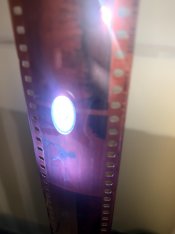So I've been having a hell of a time with the remjet layer. I can remove it very easily. Specifically, I use a microfiber cloth after bleach but before fix (easy to see the remjet and the film isn't too light sensitive). However, I always get junk left behind. Not typical remjet junk though, more like a coating of white gunk. It's easily visible when shining a light on the film backing. I initially thought it was water stains. However, it didn't come off with (yea will affect archival I know, I just wanted to test) a fairly strong acid bath, pH ~2. This seemed to tell me it isn't calcium, as it'd definitely come off. Running water on the back, the back will repel water but kinda selectively, but what water is there you can clearly see little shiny bits floating on the water that pools on the film backing, moving with the water. Even with distilled water after a lot of washing of this experimental test clip. Finally, I had the idea to use alcohol. This completely removed it by soaking, and afterwards washing with water revealed no shiny bits. The base also repels water more completely and the final dry result looks to be free of this white junk, though no idea how alcohol will affect the emulsion. I'm specifically using isopropyl, though I imagine proper expensive ethanol would likely be better to prevent the typical isopropyl "film" that can sometimes form
The real question to me is how am I not finding other people with this same problem on this forum or anywhere else. I'm following Kodak recommendations as closely as possible including the official prebath formula. I've tried many final rinse baths. All distilled water, some using photo-flo, others final rinse, others nothing. Everything from a pre-final wipe down with baking soda solution to acids to perfect pH 6.5 etc. Only solution seems to be alcohol, and even then isn't perfect. I tried to use alcohol and a microfiber cloth to wipe the back, but this was a failure. It seems like I need alcohol to make the stuff soluble, but then water to carry it away. That means I can't simply wipe down the base as I was hoping.
Am I really alone in being the only one to experience this? I'm using all Kodak vision3 films.
1st image attached is the base in the dirty form. 2nd image is after attempting to clean it by squeegee (recommended by Kodak. It scratched the emulsion to a ridiculous degree)




 .... may be it is just a too dirty soup
.... may be it is just a too dirty soup

